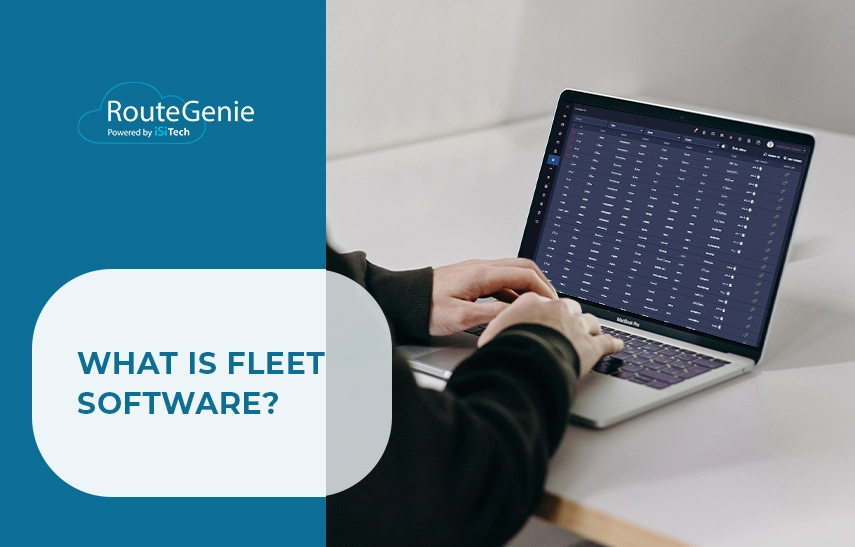What is Fleet Software?

For transport companies to serve their clients well, they need a robust system for efficiently managing all drivers and vehicles. Such a system is crucial to keep all vehicles in excellent working condition and functioning within expected costs.
With fleet management software, companies can easily control operational costs. It also tracks vehicle upkeep and maintenance, and maintains vital records for fuel consumption and mileage. No matter whether it is a taxi, delivery, or medical transportation business - the fleet management software will perform pretty similar tasks.
Contents:
- What is Fleet Management Software?
- How Does Fleet Management Software Work?
- Why Fleet Maintenance Management Software Implementation Matters
- What to Consider Before Selecting a Fleet Maintenance Management Software
- The Impact of Fleet Management Software on NEMT Safety
What is Fleet Management Software?
At its core, fleet management software monitors vehicles and drivers on one platform. These powerful tools have many capabilities, including the following:
- Schedule maintenance
- Manage fuel consumption
- Measure performance
- Monitor driver behavior
- Track vehicle and trips
- Optimize routes for clients
- Check vehicle and driver compliance
Fleet management software such as RouteGenie also has features that manage daily schedules and maintenance checkups needed for a fleet of vehicles. The software handles issues that might arise from vehicle breakdowns, trip cancellations, and driver or passenger no-shows. You can also use it to streamline your billing and payment system.
How Does Fleet Management Software Work?
The software is an overall management system for the business. All vehicles and drivers are connected to the system through an app. This app tracks fuel consumption, mileage, vehicle maintenance, and trips.
Fleet management software has many capabilities, and companies use them in many ways to streamline operations. Transport providers often use the following software features:
Transport Dispatching
The software dispatches vehicles and drivers to clients and passenger locations. These trips are monitored, tracked, and marked as a completed job or canceled trip.
Vehicle Maintenance Checks
Some companies use software for vehicle upkeep—a driver’s checklist prevents breakdowns or unscheduled downtimes. It pulls up diagnostic data from the vehicle for tracking, including battery, engine, odometer, and fuel tank.
Good fleet management software maintains records of the dates the vehicle was maintained. It should also track all vehicle breakdowns and the main reason for downtime. With this data, drivers and companies can easily track vehicle efficiency and see if keeping it is still cost-effective.
Driver Performance Monitoring
Transport companies also use fleet software to check driver behavior and performance. The software contains all relevant information, including the driver’s training record and licensing history.
If needed, management and HR teams can provide the appropriate training needed to improve driver performance. This creates a safer environment for passengers and drivers.
Fuel Usage and Analysis
Fleet management software analyzes vehicle use patterns and routes to optimize fuel use. This minimizes expenses and ensures healthy revenues for transport companies.
Service Hours and Location Tracking
Fleet management software tracks driver and vehicle locations throughout each trip. It also checks if the driver is driving within Federal Motor Car Safety Administration (FMCSA) guidelines.
Why Fleet Maintenance Management Software Implementation Matters

Leveraging fleet management software is crucial for transport companies because it is tied to costs. If it does not keep a close eye on its fleet and drivers, the business becomes vulnerable to increased expenses for maintenance and overall operations.
Vehicle breakdowns and performance issues can significantly affect revenue. They can also lead to long-term problems that will make the company lose more money.
In this era of spiraling fuel costs and an impending recession, all company decisions must be cost-effective. Maximizing efficiency is more important than ever, especially when it comes to resources and staff.
When a transport business does not have the visibility or data for fleet maintenance, expenses can balloon, and performance can drop. More repairs and replacements may be needed, and with that comes canceled trips and low customer satisfaction.
Leveraging small business fleet management software can prevent these issues and ensure the fleet runs as smoothly as possible. All drivers meet the requirements and perform well on the road. The business can then focus on providing exceptional service.
Challenges of Implementing Fleet Management Software in Transport Businesses
Data Integrity
Data must be accurate and complete when implementing fleet management software. Companies need to build processes and establish standards to ensure all data is accurate, timely, and relayed securely.
Once the new system is established, it will be the only source of data for your whole company. Data management is a crucial element of the transition, and you must invest resources to ensure integrity throughout the process.
System Maintenance
Transport providers must create a system that checks and regulates the software and all related apps. A robust backup plan must be in place so that when a disruption occurs, its effects can easily be mitigated.
Employee Preparedness and Training
All transport staff need thorough preparation training to learn how to use the fleet management software. A training plan must be outlined in detail to ensure all operations remain smooth and efficient.
Transitioning to New Platforms
Transport companies might find that transitioning to a new software platform can disrupt their operations. Introducing new software requires the combination of training staff and installing intermediate processes that minimize disruptions.
Strategies for Successful Software Implementation
It can be difficult to make everyone understand the value of fleet management software. These strategies can make implementation an easy path for your business:
Get the Buy-in From Management and Drivers
Explain to everyone how fleet management software will help you stay on track and achieve your business objectives. You can demonstrate how it can minimize cancellations and increase revenue.
Drivers can be encouraged to use the platform to improve safety and performance and increase trip completions. Explain how fleet management opens communication lines and boosts transparency on both sides.
Set Specific Goals and Metrics
Set goals that fleet software will help you meet. You can address which areas you need to improve, such as retaining and increasing the number of drivers or reducing the incidence of vehicle breakdowns.
You can use fleet management software like RouteGenie to track the data you want. Depending on the challenge you want to overcome, you can focus on specific metrics, such as completed trips, cost per mile, or fuel consumption. You can then make data-driven decisions to improve revenue and maximize resources
Set an Implementation Timeline
Create a realistic implementation plan and timeline. This will help your staff get settled into the new system and stay organized in the middle of significant changes in overall operations.
Segment the implementation process into distinct phases and set mini-milestones that focus on one software element at a time. This ensures more effortless mastery and a smoother transition into your new system.
Educate and Train All Employees
Fleet management software platforms can be installed within the vehicle, the driver’s mobile app, and the company’s computer systems.
Using a cloud-based software system makes data entry possible from anywhere. You only need to train your staff on the relevant processes related to their position and how to make the most of the software.
Focus on accurate and complete data entry required for the software to track trips, patient schedules, and pickup/dropoff points. All of these are crucial for data analysis and maintaining the efficiency of the overall system.
What to Consider Before Selecting a Fleet Maintenance Management Software

If you want to find the most suitable vehicle fleet management software for your business, consider the following:
Service Scope
Fleet software must have all the features your business needs, such as overall management, service scheduling, billing and dispatching, and more.
RouteGenie offers all-in-one solutions for everything a transport company may need. This includes scheduling, routing, dispatching, broker integration, and even HR management.
Experience and Support
Your software provider should have the requisite industry knowledge and years of experience. They should provide support before and after software implementation and initial training courses for your staff. Training videos and on-call support can make a big difference during the transition phase.
Budget
Your choice of software should be affordable, cost-effective, and take your business to the next level without breaking the bank.
The Impact of Fleet Management Software on NEMT Safety
The best fleet management software for a transport business provides many benefits: you can plan your finances, care for your staff and the team of drivers, and maintain your fleet.
But the most important impact is on the safety of your drivers and passengers while on the road. There will be fewer instances of breakdowns and traffic incidents, and your clients will feel safe when they are in the hands of a competent driver and within a well-maintained vehicle
About the author
An experienced content writer, Keren Dinkin’s forte is writing well-informed medical transportation, healthcare accounting, and related articles. Her work is backed by months of intensive research and pays meticulous attention to details. In addition to being a writer, she also dons the hat of a content strategist. The author assumes no responsibility or liability for any errors or omissions in the content of this site. The information contained in this site is provided on an "as is" basis with no guarantees of completeness, accuracy, usefulness or timeliness.